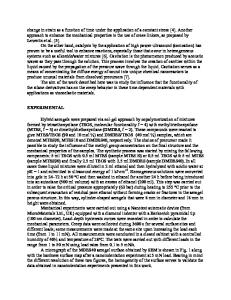Polymer-Attached Functional Inorganic-Organic Hybrid Nano-composite Aerogels
- PDF / 708,108 Bytes
- 6 Pages / 612 x 792 pts (letter) Page_size
- 121 Downloads / 343 Views
I12.24.1
Polymer-Attached Functional Inorganic-Organic Hybrid Nano-composite Aerogels Xipeng Liu, Mingzhe Wang and William M. Risen, Jr. Department of Chemistry, Brown University, Providence, RI 02912-9108, USA ABSTACT Novel materials in which modified inorganic-organic hybrid silica aerogels are attached to polymer chains have been synthesized. The aerogels are based on chitosan, a bioderived polymer from chitin, and they contain silica. The first stage of the modifications includes attachment of isocyanate, amine onto the chitosan chains embedded within the aerogel. These groups are employed in the second stage to develop the reactions required to "string" aerogel particles along functionalized linear polymers or to employ these polymers to crosslink the composite aerogels. The initial chitosan-silica aerogel particles have an ultimate size of about 2nm, and their functionally modified forms were reacted at sizes up to 1 µm. These aerogels can take up and hold dyes and water-soluble drugs. The chemistry to synthesize polyamino-siloxane based aerogel composite was discussed. In addition, two approaches to synthesize PHEMA aerogel hybrid were studied. INTRODUCTION Chitosan silica aerogels in transparent or translucent monolithic solid form have been synthesized by an initial sol-gel process, followed by extraction with supercritical CO2 [1-6]. The chitosan silica aerogels have high porosity, up to 95%(v/v), and densities ranging from 0.2 to 0.3g/cm3. The chitosan silica aerogels have average pore size of 3-5nm[2-3]. They have a three dimensional network which can be thought of as a Si-O-Si bonded framework with the chitosan polymer winding through the network like a snake that interacts with silica by both hydrogen bonds and Si-O-C bonds. In recent work, we have demonstrated that the amine groups on the chitosan in the silica network are able to react with externally provided compounds. Thus, it is possible to carry out reactions on the chitosan molecule that is essentially suspended in the dry aerogel space. That makes it feasible to do chemical reactions where water must be excluded on a molecule (chitosan) that otherwise would only be available in solvents with active hydrogen [7]. Small molecules such as bis (4-isocynatocyclohexyl) methane (HMDI), succinic anhydride (SA), isocyanatoethyl methacrylate (IEMA), and dansyl chloride (DC) have been used in this work to modify the chitosan in aerogel through chemical reactions with amines present in chitosan [7]. Of particular interest are the reaction of HMDI with chitosan silica aerogel, which results in a new -NCO terminated material, and, the reaction of IEMA with chitosan silica aerogel to produce a methacrylate terminated new aerogel material. They are valuable not only because they have new physical properties, but also because they bring new functional groups into these aerogels, making it possible to carry out new chemistries. This should lead to novel materials with varied properties. One possibility is to attach these -NCO terminated aerogel particles in th
Data Loading...











